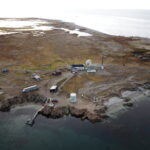Norway's Store Norske Energi has a PV system in the Svalbard archipelago, at the 78th parallel north. The islands are the last inhabited locations before the North Pole and are immersed in darkness throughout the winter.
The system consists of a series of rooftop PV systems and a ground-mounted installation. It is located near Isfjord Radio, a radio station built in 1933 as a communication point between Svalbard and the mainland. Today, it also a base camp for tourists, which is only accessible by boat or helicopter.
Mons Ole Sellevold, renewables project manager for Store Norske Energi AS, told pv magazine that the pilot project could reduce the use of fossil fuels by 70% and serve as a model for Arctic communities' transition to renewable energy.
“For the ground-mounted photovoltaic system, 360 bifacial photovoltaic panels were installed, each with a power of 550 W for a total of 198 kW system and an expected energy production of 161,000 kWh/year,” Sellevold said. “For the rooftop photovoltaic system, divided into three different buildings, the panels installed are of 231 W and 415 W each and the total installed capacity is 96 kW with an estimated energy production of 60,000 kWh/year”
The project manager also provided the details of the battery storage system.
“The battery storage reaches 405 kWh while the inverter capacity is 240 kW. There is also thermal storage: 12,000 liters of hot water in 12 storage tanks.”
Regarding the works, as expected, the Isfjord Radio construction site was challenging.
Popular content
“The foundations had to be poured into permafrost and the work was carried out in difficult arctic conditions, with snowdrifts and loads of wind, snow and ice,” Sellevold explained. “Furthermore, the work had to be carried out with as little disruption to tourists and wildlife as possible.”
Before the start of the energy transition, Isfjord Radio used almost 200,000 liters of diesel per year. So far, the installation of a battery bank and a thermal storage system has significantly reduced diesel consumption. It is expected that with solar panels in operation, there will be a 70% reduction in the use of fossil fuels.
“We are well underway in establishing Isfjord Radio as a pilot for emissions-free hybrid energy systems for off-grid communities in the Arctic,” Store Norske Energi CEO Heidi Theresa Ose told pv magazine. “The long-term goal is to arrive at a completely renewable solution.”
Isfjord Radio relies on an autonomous energy system, where hybrid solutions including renewable energy production, energy storage and diesel generators are being tested, which can then be deployed in many of the approximately 1,500 Arctic communities not connected to one central energy grid and rely mainly on coal or diesel as an energy source. “
“Our shared responsibility to reduce greenhouse gas emissions, security of supply, secure energy production, and the particularly high costs of fossil energy in the Arctic are critical considerations and driving forces of this energy transition,” the company said in a press release.
This content is protected by copyright and may not be reused. If you want to cooperate with us and would like to reuse some of our content, please contact: editors@pv-magazine.com.







that is awesome. I believe that each new building should be required to have PV and storage. De-centralization of the grid is the only really sustainable option.